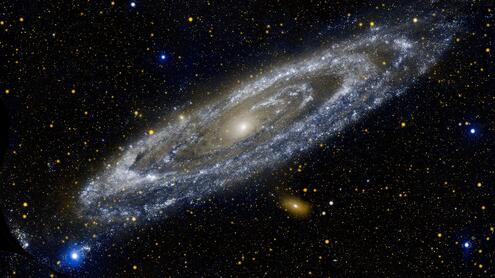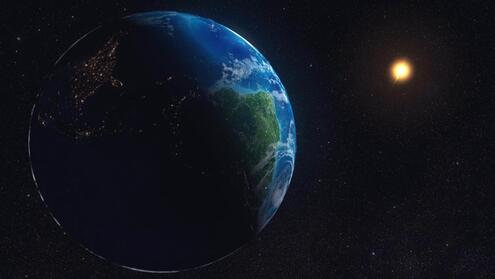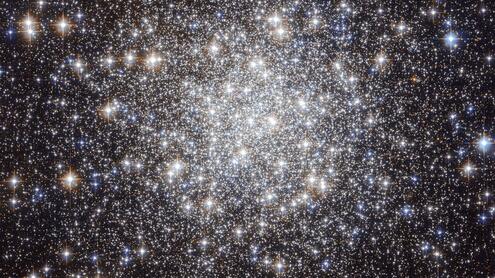What do you know
about STARS?

How many stars are there in the Milky Way Galaxy?
200,000
200 million
200 billion
ANSWER: 200 billion
Our Sun is one of more than 200 billion (200,000,000,000) stars in the Milky Way Galaxy . Every individual star that you can see with the naked eye is in the Milky Way. We can observe more than 100 billion other galaxies beyond the Milky Way.

Most stars form in tightly packed groups called:
star clusters
star huddles
star formations
ANSWER: star clusters
Our star, the Sun, was born, along with hundreds to thousands of other stars in a star cluster. As with many young stars, the Sun was ejected from its cluster. Since then it has traveled, along with its planets, in orbit around the center of the Milky Way.
A star's mass is the most important thing that determines:
its temperature, luminosity, and color
how it will live and die
all of the above
ANSWER: all of the above
The more massive a star is, the hotter it burns. The hotter it burns, the faster a star uses up its fuel and the shorter its life is. The hottest and most massive stars are blue and bright. The coolest and least massive stars are red and dim.

How do most stars end their lives?
The outer layer swells, and the star becomes a red giant.
The core shrinks, and the star becomes a white dwarf.
First a, then b.
ANSWER: First a, then b.
Most dying stars—including our Sun—will become red giants, then white dwarfs. It takes billions of years for the white dwarfs to cool down and fade away. 99% of stars end their lives like this.

At the end of its life, a very massive star will run out of fuel and explode as a:
superstar
supernova
superbang
ANSWER: supernova
It's very rare for a star to "go supernova." Only about 1% of stars are massive enough to explode as one. Supernovas occur somewhere in the Milky Way Galaxy once every 50-100 years on average.
How does our star, the Sun , compare to other stars?
more massive than average
close to average
less massive than average
ANSWER: more massive than average
Surprise! The Sun is not your average star. It is a middle-aged yellow star that is more massive than nearly 90% of stars.
The Sun contains what percentage of the Solar System's mass?
8.96%
68.9%
98.6%
ANSWER: 98.6%
Our Sun is the hulk of our Solar System . The other 1.4% is in the planets, moons, asteroids, comets, gas, and dust that orbit the Sun.

About how long does the Sun's light take to reach Earth?
8 minutes
8 hours
8 months
ANSWER: 8 minutes
Light travels incredibly fast—at a speed of 186,000 miles per second. Sunlight reaches us about 8 minutes after it leaves the Sun. A light-year is the distance light travels in one year.
How long does it take our Solar System to orbit the center of the Milky Way Galaxy?
25,000 years
250,000 years
250 million years
ANSWER: 250 million years
It takes one "Galactic Year," or 250 million years, for our Solar System to circle the center of the spiral-shaped galaxy once. Dinosaurs first appeared about one Galactic Year ago! The Earth formed 18 Galactic Years ago.

Around the world today, astronomers observe stars using telescopes :
on Earth
in space
on Earth and in space
ANSWER: on Earth and in space
To study stars near and far, astronomers analyze their light using telescopes on Earth and in space. In the universe as far as our telescopes can ever see, there are perhaps 20,000,000,000,000,000,000,000 stars! Or more.
You might also like...
Image Credits:
Milkyway, NASA/JPL-Caltech; Christmas Tree Cluster; NASA//JPL-Caltech/P.S. Teixeira (Center for Astrophysics); exploding star’s shockwave, NASA Ames/W. Stenzel; 4b white dwarf star, NASA, ESA, H. Bond (STScI) and M. Barstow (University of Leicester); 9. Sun and Earth, NASA Goddard Space Flight Center; globular cluster Messier 56, NASA & ESA;




 Biodiversity
Biodiversity
 Brain
Brain
 Genetics
Genetics
 Marine BiOLogy
Marine BiOLogy
 MicrobiOLogy
MicrobiOLogy
 PaleontOLogy
PaleontOLogy
 ZoOLogy
ZoOLogy
 AnthropOLogy
AnthropOLogy
 ArchaeOLogy
ArchaeOLogy
 Astronomy
Astronomy
 Climate Change
Climate Change
 Earth
Earth
 Physics
Physics
 Water
Water
